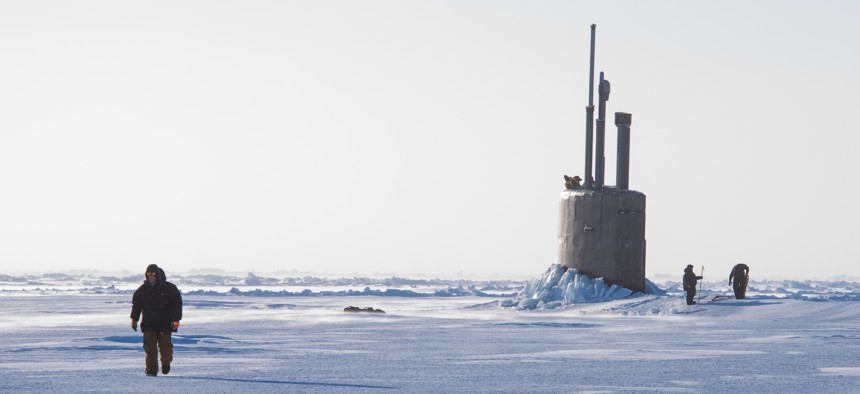
Seawolf-class submarine The Seawolf-class fast-attack submarine USS Connecticut (SSN 22) breaks though the ice in the Beaufort Sea in support of Ice Exercise (ICEX) 2018. US Navy
Admiral: The US Is ‘Operating Blind’ In the Arctic
The Navy needs more weather data to better operate in the cold northern seas.
When it comes to predicting fluctuations in Arctic weather, the United States is “operating in the blind,” the U.S. Navy’s chief meteorologist said Monday.
The northern polar region is heating up about twice as fast as the rest of the globe, creating wildly variable weather and conditions that don’t happen anywhere else. As climate change makes the Arctic more accessible, the Navy’s ships, subs, and aircraft need better weather models to help them operate in the region’s chaotic seas, Rear Adm. John Okon told an audience at the Navy League’s Sea-Air-Space conference on Monday.
Okon said relatively small atmospheric events in the Arctic, sometimes called polar lows, can be as dangerous as hurricanes at lower latitudes. They “develop quick and move really fast,” he said.
Over the next three years, the Navy Research Lab, NOAA, and other partners will work to develop better predictions through the Earth System Prediction Capability, which Okon described as “a national effort to develop and deliver a fully-coupled air, ocean, ice and land models.”
Related podcast:
But, he says, having good modeling software doesn’t do you much good without the hard data on Arctic conditions to run the models.
“In the Arctic, traditional sensors that provide the bulk of observations in the mid and low [latitude locations] just don’t work,” he said. “Things like geostationary satellites that provide the environmental observations, gliders, argo floats; they don’t provide the access or persistency required of the Arctic Ocean,” he said.
As a result, the Navy doesn’t have the hard data to make predictive models run as well as they are supposed to. “The current amount of observations that we have in the Arctic are similar to the amount of observations we had over the U.S. and in the Atlantic during WWI,” he said.
Related: Pentagon Warns Of China’s Rise in the Arctic, Missile Subs, Influence Operations
Related: Russia Plans More Arctic UAVs
Related: As The Arctic Warms, US Navy Considering Summer Transit, Bering Sea Port
What he says he needs from the science and technology community is better batteries for sea and air drones so they can stay out longer to collect more data. “One of the limiting factors for unmanned vehicles right now is battery technology. Right?” He says he’s looking for “low-cost persistent sensors that can operate...in the upper two or three hundred meters where the runoff from the Ice and the snowpack from the land are affecting that acoustic signature.”




